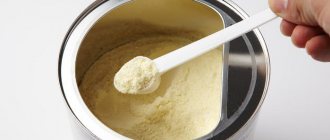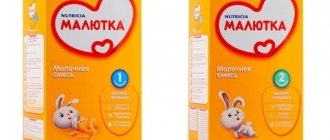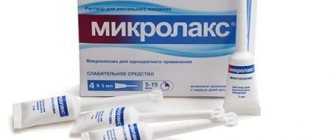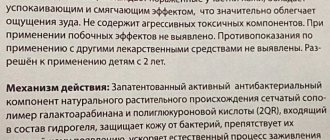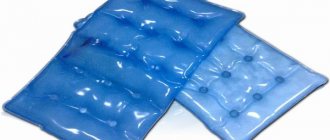Malyutka powdered milk formula is one of the most popular brands on the breastfeeding substitute market; it is used for feeding infants and young children. Produced from adapted milk, the main component is whey.
The protein is in a split form, which facilitates its good absorption by the child’s body. The “Malyutka” mixture contains casein, which is rich in calcium and phosphorus. These elements have a stimulating effect on the body's immune system. Manufacturer: .
Compound
Malyutka is a mixture for newborns, reviews of which are in most cases positive. Its composition is developed in accordance with current recommendations of the World Health Organization. All components of the mixture are carefully selected by the manufacturer to ensure the harmonious development and proper growth of the child in the first 2 years of his life.
Malyutka 1 infant formula is suitable for children from birth
The main composition of the Malyutka 1 milk formula:
| Component name | Description |
| Demineralized whey | This component is necessary for better absorption of formula. |
| Skim cow's milk | This is the basis of baby food. The cow's protein in milk is processed in such a way as to reduce the likelihood of an allergic reaction in the child. |
| Whey protein concentrate | This component makes the mixture more nutritious. |
| Prebiotics GOS/FOS | They improve the functioning of the gastrointestinal tract and help reduce the likelihood of dysbiosis, diarrhea or constipation in the child. |
| Lactose | Helps the baby digest formula and stimulates the growth of bifidobacteria in the baby's intestines. In addition, this component promotes better absorption of magnesium, calcium and manganese. |
Additional components of Malyutka 1 milk formula:
| Component name | Description |
| Mortierella alpina mushrooms | Promote the synthesis of arachidonic acid. |
| Meltodextrin | A food additive that affects the viscosity of infant formula. It allows you to increase the periods between feedings. |
Vegetable oil mixture:
| Vegetable oils are necessary to compensate for the lack of fat in baby food. |
| Fish fat | Source of polyunsaturated acids. |
| Inositol | Participates in the construction of bone and muscle tissue. |
| Kholin | Participates in the metabolism of fats, removes harmful compounds from the child’s body. |
| Taurine | Free sulfonic acid, the main function of which is the formation of brain tissue and retina. |
| Emulsifier soy lecithin | A nutritional supplement that takes part in the normal development of the central nervous system of a newborn child. |
| Nucleotides | Accelerate cell growth and maturation. In addition, nucleotides are a universal source of energy. |
| L-tryptophan | An essential amino acid necessary for the production of serotonin (the good mood hormone). |
| Arachidonic acid | This unsaturated fatty acid performs the following functions:
|
Vitamin complex and minerals included in the Malyutka 1 milk formula:
| Component name | Main functions |
| Calcium |
|
| Phosphorus |
|
| Potassium |
|
| Sodium |
|
| Magnesium |
|
| Copper |
|
| Manganese |
|
| Chlorides |
|
| Zinc |
|
| Iodine |
|
| Selenium |
|
| Retinol A |
|
| Tocopherol E |
|
| Thiamine B1 |
|
| Vitamin D |
|
| Vitamin K |
|
| Riboflavin B2 |
|
| Pantothenic acid |
|
| Niacin RR |
|
| Pyridoxine B6 |
|
| Cyanocobalamin B12 |
|
| Biotin |
|
The manufacturer additionally adds iron and ascorbic acid to the composition of Malyutka 2, 3 and 4 mixtures. Iron is one of the components of hemoglobin. This trace element promotes the capture and transfer of oxygen from the lungs to the cells. Ascorbic acid helps improve the absorption of iron.
In addition to the components listed in the tables, the adapted fermented milk mixture Malyutka contains a special starter (lactic acid bacteria, bifidobacteria), which helps support the baby’s natural digestion. It ensures the health of the newborn's digestive system, helping to get rid of problems such as colic, flatulence and constipation.
All Malyutka mixtures do not contain:
- GMO.
- Dyes.
- Flavors.
- Sugar.
Malyutka (a formula for newborns, reviews of which will help you decide whether to switch your child to a similar diet) may contain traces of gluten. Therefore, it is not recommended for children with congenital gluten intolerance.
Feeding a child from 1 year
The child grows up, and after 1 year he needs a wider diet than before. If previously the baby ate mainly mother's milk, cereals and vegetables, now it is time to introduce meat and fish, eggs and fruits, and some other dairy products as the basis of nutrition.
The consistency of the food also changes. If previously the baby ate food only in the form of a homogeneous creamy puree, now, after the appearance of his first teeth, his food should contain small lumps and pieces. Vegetables and fruits can simply be mashed with a fork without worrying about absolute uniformity. But meat and fish, of course, should only be cooked in the form of meatballs, cutlets and meatballs.
Important! The baby's food should be prepared in a way that is gentle on his gastrointestinal tract: only steamed, boiled and baked.
Dairy products must remain in the daily diet. It is advisable to accustom your toddler to a diet. Main meals should be 5 times a day. But between them there is always additional food: milk, fruits, compotes, cookies.
Baby milk "Malyutka-3" can be consumed once or twice a day, for example, as an afternoon snack or for calming before bed. If you give it to your child in between meals, it will be an excellent vitamin supplement to the daily diet.
Did you know? Oddly enough, mother's milk for a daughter and for a son differs in its composition.
Women who have given birth to a boy have more proteins and carbohydrates in their milk than those who have given birth to a girl.
In what form is it produced?
The manufacturer Nutricia produces Malyutka milk formula in the form of a dry powder, which should be diluted with warm water before use. The mixture is reliably protected from environmental influences by aluminum foil.
The foil, in turn, is placed in thick cardboard packaging with a volume of 300, 600 and 1200 g. In addition to the milk mixture, a measuring spoon made of food-grade plastic is included.
Types of Malyutka mixtures:
| Variety | What age is the mixture aimed at? | Purpose |
| Powdered milk mixture | From birth to 1 year. | For a complete meal for children who do not have health problems. |
| Fermented milk mixture | From birth to 1 year. | Intended for children who have digestive problems or have had an intestinal infection. In addition, it is prescribed to children with decreased appetite. |
| Baby milk | From the 1st year until the end of the period of feeding with artificial milk (as a rule, this period begins when the child turns 2 years old). | For children who have left infancy and do not have health problems. |
Estimated cost of different types of Baby formula:
| Cost, rub. | ||||
| Volume 300 g | Volume 350 g | Volume 600 g | Volume 1200 g | |
| Baby 1 | 285 | — | 470 | 832 |
| Baby 2 | 285 | — | 479 | 832 |
| Baby 3 | 283 | — | 501 | 891 |
| Baby 4 | 277 | — | 500 | — |
| Malyutka fermented milk mixture | — | 472 | — | — |
Classification of Baby formulas by name:
| Blend name | Description | Peculiarities |
| Baby 1 | Powdered milk mixture | From birth to 6 months. |
| Baby 2 | Powdered milk mixture | From 6 months to 1 year. |
| Baby 3 | Baby milk | From 1 year to 1.5 years. |
| Baby 4 | Baby milk | From 1.5 to 2 years. |
| Baby fermented milk | Dry fermented milk mixture | From the first days of life to 1 year. |
About company
Nutricia is part of the Danone group of companies. Unlike other holding companies, Nutricia specializes in scientific development and production of products that, for one reason or another, are not suitable for most people. Currently, the company owns 21 baby food factories in different countries and is engaged in scientific research in the field of feeding children with lactose intolerance and metabolic disorders. That's why Nutricia's baby food line offers options for babies who have various problems with digestion and absorption of beneficial microelements - they are designed to meet all needs.
Baby formulas "Malyutka" are produced in Istra, near Moscow, as well as at enterprises in Belarus and Ukraine.
Action
Malyutka milk formula contains all the components that a child needs from birth to 2 years. Thanks to this, this type of baby food can be used by mothers who, for some reason, do not produce breast milk or produce it in an amount insufficient for adequate nutrition of the child.
Main functions of Malyutka milk formula:
- Strengthening the newborn's immunity.
- Normalization of intestinal microflora.
- Ensuring normal growth and development of the baby.
Malyutka fermented milk mixture is a therapeutic food prescribed by a doctor for children with a sensitive digestive system.
It can be used both as the baby’s main food and in combination with breast milk or other formula.
Malyutka fermented milk mixture has the following effects:
- Reducing colic in the first 4 months of a child’s life.
- Regular bowel movements.
- Ensuring comfortable digestion.
Reviews of Malyutka fermented milk formula for newborns show that the effect of regular use of this type of baby food can be noticed within a week. Gradually, the child’s stool normalizes, the process of gas formation and bloating decreases.
Preparation
Choosing the right formula (no one can guarantee that this particular formula will suit a particular child) is only the beginning of the whole journey. The mixture must be prepared correctly so that every milligram of nutrients is beneficial.
Preparatory stage
Prepare and dry clean bottles, which pediatricians usually recommend boiling or steaming, especially in the first 2-3 months. Pediatrician Komarovsky believes that this is an unnecessary measure and a simple scalding with boiling water is enough. Prepare nipples for the bottle and a clean measuring spoon from the packaging in advance: you cannot use measuring spoons from other formulas for “Malyutka”. Their capacity may vary.
Proportions calculation table
| How old is your baby? | How much to feed per day? | How much water do you need? | How many scoops of Malyutka-1 food? |
| 0-14 days | 6-7 | 90 | 3 |
| 3-8 weeks | 6-7 | 120 | 4 |
| 2 months | 6 | 150 | 5 |
| 3-4 months | 5 | 180 | 6 |
| 5 months | 4-5 | 210 | 7 |
| 6 months | 3-4 (introduce complementary foods) | 210 | 7 |
How to properly dilute baby milk?
Do not use leftover mixture by mixing it with a new portion. This is a simple, but most broken rule of all.
How to properly feed your baby:
- Heat clean, boiled water (if the baby is a newborn, it is better to use special baby water that does not require boiling). The required temperature is 40 degrees.
- Measure the required amount according to the scale on the bottle: 1 spoon requires 30 ml of water. For example, we pour 210 ml for a 5-month-old child.
- Add the mixture using a standard packet spoon. You need a full spoon, but without a pile on top, which we remove with a knife.
- Screw the cap onto the nipple tightly and shake the bottle, holding the hole with your finger. You need to shake until the food is completely dissolved.
Application
Baby formula can be given to a newborn from the first minutes of his life. As a rule, this type of nutrition is prescribed by an experienced neonatologist or pediatrician.
You can prepare the milk mixture yourself. This requires a small number of components:
- Purified water intended for children (you can buy it at almost any pharmacy or supermarket).
- A saucepan or kettle for heating water.
- Utensils for feeding a child. As a rule, this is a bottle with a special nipple, the size of which corresponds to the baby’s age.
Sequence of preparing milk mixture:
- Wash your hands well using baby or laundry soap.
- Use hot water to clean the baby's feeding utensils. You can also use a special bottle sterilizer.
- Bring water intended for children to a boil.
- Cool the water to 50˚C.
- Pour chilled water into prepared baby dishes.
- Pour the required amount of mixture into baby dishes (1 spoon of dry mixture per 30 g of water).
- Shake the bottle until the mixture is completely dissolved in the liquid.
- Cool the temperature of the baby food to 36-37˚C.
When preparing milk formula, you need to pay attention to the following points:
- The mixture should be prepared immediately before feeding the baby.
- To prepare the mixture, it is prohibited to use water from wells, as well as tap and mineral water.
- It is forbidden to use the remains of the finished mixture for the next feeding.
- It is not recommended to give a child formula whose temperature is above 37˚C. It is better to give baby food 2-3 degrees colder than to give it 1 degree hotter.
- You can store the milk mixture for no more than 60 minutes. If the baby has not finished the baby food, it is not recommended to leave it until the next feeding of the baby.
Reviews from forums
anuta1985. My daughter has been feeding on “Malyutka” formula since she was 3 months old. When it became expensive to buy infant formula from foreign manufacturers, I wondered what could replace it. There was a program on TV about a control purchase about milk formulas, formulas from 6 manufacturers were presented and what was my surprise when “Malyutka” took first place, a number of studies were carried out that showed that our domestic baby meets all the requirements and does not harm the health of our babies!! And one of the many important things is its price!!
beauny. For my daughter this is the best mixture. For me it is also the cheapest. It so happened that almost from the first month I had to feed my baby formula. She was gaining weight poorly and screamed all the time. We tried a lot of mixtures then, expensive, advertised and not so much. And none of them were suitable, the expensive ones were of course suitable in quality, but in terms of price they were not at all profitable. Meanwhile, the daughter kept screaming. It is understandable that in the first 3 months they are worried about their tummies, but not around the clock! So, in the nearest store we bought “Baby 1” (which is recommended for babies from 0 to 6 months). We tried it, and that same day we slept peacefully all night! After that, we began to confidently get better and this became our permanent choice. Now we have already switched to “Baby 3”, which is recommended for toddlers from 1 year. Compared to others, the “Malyutka” mixture, in my opinion, is sweeter, apparently more pleasant to the taste, because after trying it, my daughter reluctantly drank the others, did not finish the bottle, but drank the entire “Malyutka”. It is even different in color - slightly yellowish. Dissolves well. No sediment. And the stool after it is normal and regular, which is important.
ilji4yova9433. “Baby”, intended from birth for feeding young children, contains all the necessary vitamins and minerals, the packaging bears a quality mark and a sign “does not contain GMOs,” which already predisposes one to this product. But there are also disadvantages: it may not be suitable for a child and may cause constipation. But as you know, not everyone can afford expensive, imported formulas, so “Malyutka” is an ideal solution for many mothers. I myself am a regular customer because: 1. I trust domestic manufacturers more.2. the price in relation to other mixtures is relatively adequate.3. available for sale. If I was asked if I would change “Malyutka” to another more expensive mixture, I would most likely answer no than yes. More than one generation has grown up on these mixtures and I hope this tradition will continue.
Do you want to be the first to read our materials? Subscribe to our telegram channel, Facebook page, or VKontakte group.
We are at Yandex.Zen - join us!
Contraindications
Baby (a formula for newborns, reviews of which help form an opinion about this type of baby food) has the following contraindications:
- Allergy to components of the mixture . If an allergic reaction occurs, you must contact a specialist so that he can select a different milk formula for your child.
- Galactosemia . With this disease, it is necessary to completely eliminate lactose and galactose from the child’s diet. To feed a newborn, the doctor prescribes a lactose-free formula.
- Cow's milk protein intolerance . In this case, the doctor prescribes a mixture based on goat milk.
Manifestations of lactase deficiency in a child
You can determine that formula milk is not suitable for your child by paying attention to the presence of the following points:
- The occurrence of diathesis after taking formula.
- Regular gastrointestinal problems: frequent gas formation, constipation or diarrhea.
- Weight gain is below normal (100-200 g/month).
Reviews about the mixture
According to reviews, “Malyutka” is not inferior to more expensive adapted mixtures in terms of basic indicators. Among its benefits is a balanced complex of prebiotics, which often helps to cope with constipation.
You can often find reviews of rashes and digestive problems in infants after introducing formula as complementary foods, which go away after switching to lactose-free formula. The appearance of rashes, constipation or excessive regurgitation in this case indicate a previously undetected lactose intolerance and are not associated with the components of the mixture.
The advantages of many young parents include the low price and nutritional value, as well as the low molasses content compared to other manufacturers. The finished mixture does not taste sweet, but slightly sweetened, so if necessary, the child can easily switch to another complementary food.
Side effects
Most often, side effects from consuming Malyutka milk formula occur in the case of lactase deficiency or intolerance by the child to any component included in the baby food.
Possible side effects:
- Colic.
- Flatulence.
- Allergic reaction.
- Frequent regurgitation.
- Constipation.
- Diarrhea.
If any side effects occur, you should contact your pediatrician or neonatologist, who will help you choose another suitable formula for the child.
Varieties of milk porridges
Milk porridge “Malyutka” is available in the following types:
- Wheat with fruit, from 12 months. Contains a partially adapted milk mixture, a mixture of vegetable oils: palm, coconut, rapeseed, sunflower), soy lecithin, complex food additive, sugar, minerals, maltodextrin, vitamins, rice flour, natural additive from pears, bananas, peaches. Maltodextrin is a carbohydrate component that has a prebiotic effect, is easily digested in the gastrointestinal tract, promotes better absorption of vitamins and microelements, and has a pleasant sweetish taste.
- Corn and rice with fruit, from 8 months. Porridge is a good source of energy and rice contributes to the proper functioning of the baby's intestines.
- Multigrain with cookies, from 6 months. Takayakasha "Baby" is
an ideal source of energy for a growing child. The whole grains included in the product contain more vitamins and fiber than regular cereals. The porridge also contains special children's cookies, which will not only give the baby pleasant moments, but also introduce a new taste. - 7 cereals with lemon balm, from 6 months. Contains wheat, hydrolyzed wheat, rye, millet, barley, oats, corn, rice, sugar, vitamins. Porridge provides the child's body with energy and helps the normal functioning of the intestines.
- “Rainbow of Flavors” - a set of cereals in bags, from 6 months. Contains 5 packages of milk porridges: “Wheat milk porridge with banana”, “Buckwheat milk porridge with apple and carrots”, “Multi-grain milk porridge with fruits”, “Wheat milk porridge with pumpkin”, “Oatmeal milk porridge with fruits”.
- Buckwheat, rice, apricot, from 4 months. Porridge with buckwheat and rice with the addition of apricot will diversify your baby’s diet and provide a balance of microelements and vitamins. Buckwheat will saturate the child with B vitamins, valuable amino acids and minerals, and rice and apricot will ensure comfortable digestion.
- Buckwheat, from 4 months. This “Malyutka” porridge is a perfectly balanced first complementary food. It is rich in essential microelements and does not contain gluten. And B vitamins, valuable amino acids and minerals are necessary for the child’s body for full development and growth.
- Buckwheat with prunes, from 4 months. Prunes stimulate the intestines and contain antioxidants that are involved in the proper functioning of the immune system.
- Corn, from 5 months. Porridge has an ideal balance of minerals and vitamins, which provides complete nutrition for the child. It is easily digestible, has high nutritional value and regulates the functioning of children's intestines.
- Multigrain, from 6 months. Porridge is an ideal source of carbohydrates that provide the baby with energy. The rice, buckwheat, and corn included in the formula are easily digestible and provide the child with valuable minerals and amino acids necessary for a growing body.
- Oatmeal, from 5 months. This porridge has a positive effect on the functioning of the heart. Cereals are rich in potassium, magnesium, B vitamins, help intestinal function and facilitate the digestion process.
- Wheat with banana, from 6 months. Wheat and banana will provide the baby with the necessary energy. Nutritious bananas will improve your mood, and your baby will get proteins, easily digestible carbohydrates and potassium from wheat.
- Multigrain with mixed fruit, from 6 months. This product will help develop your child’s sense of taste. Cereals will give you strength for new achievements, and fruits will give you real pleasure.
- Wheat with pumpkin, from 5 months. Wheat will provide energy to a rapidly growing body, and beta-carotene contained in pumpkin will contribute to the normal development of vision organs.
- Oatmeal with fruit, from 5 months. This “Malyutka” porridge contains a whole complex of important minerals and vitamins, without which the proper development of a child is impossible.
- Rice, from 4 months. Rice is 97% carbohydrates, which is pure energy, gluten-free, yet highly nutritious. Useful for mild digestive disorders.
- Multigrain with fruit, honey, and corn flakes, from 15 months. Porridge has a rich, rich taste and introduces the baby to new foods.
Advantages and disadvantages
Malyutka is a formula for newborns, reviews of which will help determine the main advantages and disadvantages of this type of baby food.
The main advantage of this milk formula is its affordable price for a wide range of consumers.
Despite the low price, the mixture is of sufficient quality, balanced and nutritious.
Other advantages of the Malyutka mixture:
- Contains a complex of minerals, vitamins and other substances necessary for the health and proper development of the child.
- Sweet taste and pleasant smell of baked milk.
- Composition as close as possible to breast milk.
Like any other baby food, Malyutka milk formula has a number of disadvantages. Its main disadvantages include:
- The presence of palm oil in the mixture.
- Short measuring spoon.
- Inconvenient packaging.
- Presence of soy lecithin.
Baby formula for newborns is an excellent alternative to breastfeeding , which is confirmed by numerous reviews from parents. It can also be used as supplementary feeding if the mother has a lack of breast milk or the child has insufficient weight gain.
Which formula should I choose for my baby?
On the shelves of pharmacies and stores there are a huge number of described goods of domestic and foreign production, among which it is easy to get lost. It is a mistake to focus on cost as an indicator of quality. The rating of infant formula shows that cheap products are often better than expensive ones
It is important for parents to study the composition of the diet and the extent to which it corresponds to the age and needs of the baby.
Which formula is best for a newborn?
The described early nutrition group is marked with the number “1” on the packaging by all manufacturers. Infant formulas from 0 to 6 months should be maximally adapted for infants, close in chemical content to natural breast milk (unless there are other medical recommendations). It is advisable that the product does not contain rapeseed and sunflower oil.
Rating of formulas for newborns, based on the opinions of pediatricians:
- Nutrilon from Nutricia.
Produced in Holland, enriched with nucleotides, polyunsaturated fatty acids, prebiotics, vitamins and minerals. This is the best formula for newborns, but expensive. - Baby (manufacturers – Russia and Ukraine).
A very popular product due to its excellent quality and low price. The formula is maximally adapted for infants aged 0-6 months, is easily digestible and is similar in composition to breast milk. - Similac from Abbott.
Produced in Denmark, contains prebiotics, iodine, taurine and lactose. The product has a beneficial effect on digestion, prevents colic and reduces gas formation. - NAN from Nestle.
Swiss mixture, but subsidiaries can be located in any country. This diet contains a complex of valuable vitamins and microelements, therefore it strengthens the baby’s immunity and helps the functioning of the gastrointestinal tract. - Nestogen, also manufactured by Nestle.
The mixture contains prebiotics, which ensure comfortable digestion and the absence of problems such as flatulence, excessive regurgitation, constipation or diarrhea.
Rating of products that include specialized treatment series (hypoallergenic, for intestinal problems, lactose intolerance, and others):
- Nutrilak;
- Nanny;
- Kabrita;
- Alphare.
Formula for children from 6 months
After six months, babies digest cow's milk more easily; their diet may contain partially hydrolyzed proteins. Such infant formulas are marked with the number “2” on the packaging. They are less saturated with vitamins and minerals, pre- and probiotics, because the introduction of complementary foods begins at 6 months. A rating that allows you to determine which infant formula is better at a given age:
- Nutrilon;
- Materna;
- Nuppi;
- Similac;
- Baby;
- Nestogen;
- NAN;
- Semper;
- Agusha;
- Enfamil.
Which formula should I choose for a child after one year?
A child over 12 months digests milk protein well, but is not yet ready for a natural product, either cow or goat. Infant dry formulas, concentrates or ready-made liquids for one-year-old babies are marked with the number “3” on the label. They are included in the group of partially or unadapted nutrition, which may include processed milk powder. List of mixtures recommended by pediatricians:
- Nutrilak;
- Baby;
- Peptamen;
- NAN;
- Kabrita.
Which formula should I choose for premature babies?
A prematurely born baby needs food with increased energy value and an increased concentration of vitamins, micro- and macroelements. A pediatrician should advise which formula to choose for a newborn premature baby. This type of product is marked with the number “0” or the letters “pre”, “pre” in the name. The best formula for newborns born prematurely can be selected from the following list:
- NAN;
- Aptamil;
- Nutrilon;
- Similac;
- Nutrilak.
Basic rules before choosing formula for a newborn
You should choose a formula for artificial feeding of a newborn after consulting a pediatrician. However, every caring mother should know a few rules that will help her choose the right baby food that will be ideal for her child.
- you need to buy formula only taking into account the child’s age;
- a healthy child should choose highly adapted formulas for the first six months of life;
- you should carefully study the composition of the mixture, the amount of ingredients, and calorie data;
- The mixture must contain taurine, which is involved in the formation of brain tissue and retina. This amino acid also improves the digestion and absorption of fats, improves immunity and is considered extremely necessary in the first months of a newborn’s life;
- the presence of carnitine is desirable - it is involved in the metabolism of fats, proteins, vitamins and energy inside the cell;
- the composition should contain linoleic acid - promotes the proper formation of the brain and internal organs;
- check the expiration date of the mixture;
- become familiar with the method of preparing the mixture; it should be clear and understandable for every mother;
- if the mixture suits the baby well, you need to be sure that there will be no problems with its purchase in the future; you can purchase several packages;
- As the child grows, the formula needs to be changed, so it is recommended to use the same manufacturer for the second half of life.
Choosing a formula for mixed feeding
Which formula is best for newborns with mixed feeding is decided by the doctor and the parents of each individual child. Its composition necessarily includes iodine, taurine, nucleotides, polyunsaturated fatty acids, vitamins, minerals, pre- and probiotics. Among the ingredients in high-quality infant formulas there is no palm oil, significant amounts of sugar and starch. With the help of artificial nutrition, some problems with the baby’s health are solved:
- for constipation, infants are given fermented milk mixtures;
- for acute intestinal infections, substitutes with a low amount of lactose are chosen;
- For lactose intolerance, lactose-free mixtures are suitable;
- when regurgitating, anti-reflux mixtures with increased viscosity are used;
- when diagnosing an allergy, a hypoallergenic mixture labeled “HA” and “NA” is selected based on hydrolyzed proteins.
The top list of the best infant formulas will tell you which formula to choose for newborns with mixed feeding:
- Friso is a complementary feeding mixture for premature and low-weight infants. Enriched with iodine and amino acids, which have a beneficial effect on the development of the central nervous system and digestive system. The downside is that it contains palm oil.
- Nutrilak (Nutrilak). Thanks to the increased amount of nutrients, it strengthens the immune system and promotes proper digestion. The main advantage is that it does not contain palm and rapeseed oils.
- Similac (Similac) is a highly adapted mixture that relieves the symptoms of colic and constipation, does not contain palm oil.
- Nanny is created on the basis of goat's milk and is intended for children with intolerance to cow's milk. It is rarely an allergen in infants.
- Malyutka is a domestic mixture with a very affordable price. The composition includes prebiotics, iodine, fatty acids, palm oil, does not contain sugar.
Manufacturers offer a choice of baby food for newborns, and parents must consult with a pediatrician which is best before they start feeding the baby.
How do you know if “Malyutka” is suitable for your child?
Everything is individual, and even popular Russian adapted artificial milk may not suit your baby. To make sure that the formula you are feeding your baby is suitable for him, answer the following questions for yourself and your pediatrician:
- Does your child often have tummy problems? Severe gas formation, colic, diarrhea, constipation? If the answer is “yes,” consider whether you should try a mixture with Malyutka Premium prebiotics or, if you are already on it, switch to another company.
- Is the child's weight gain within the normal range? Has your baby stopped gaining weight or, on the contrary, is he gaining too much? Consider trying a different blend.
- Does your baby have allergies? For example, diathesis. If the answer is “yes”, analyze whether the child may be allergic to cow protein or one of the ingredients of the Baby formula.
Baby food "Malyutka" is a budget-friendly, high-quality version of adapted artificial milk for babies. It can easily be found in supermarkets and pharmacy chains; it has a pleasant, almost neutral taste and smell, unlike some expensive European mixtures. Provided that your child is not allergic to the ingredients, and this mixture suits his body, the described products will become your assistant in creating your child’s diet for many months.
Breastfeeding is an important, responsible activity. The baby receives all the necessary vitamins and microelements from mother's milk.
What should mothers do who, for whatever reason, can breastfeed their baby?
On the shelves of stores and pharmacies you can find a lot of different dry formulas for feeding babies. Even pediatricians have a hard time understanding the wide range of products and recommending the best product for feeding a newborn. The following material is dedicated to the Baby 1 infant formula, the manufacturing company is a leader in the market of inexpensive, high-quality food products for children; it has existed since 1972.
How to correctly move from one mixture to another?
Many mothers wonder how and when to correctly switch from artificial milk intended for a child of the same age to milk intended for an older baby? Adapted artificial milk, no less than complementary foods, requires gradualism and thoughtful actions. Here are a few important rules:
- Move on to something new gradually. We wrote earlier that Malyutka has different compositions for different ages. A new mixture is stressful for the baby’s body. Introduce new food first once a day, then 2 times, then replace half of the daily ration with a more mature formula. Often mothers immediately switch to the older Baby, which causes severe colic and indigestion in the child.
- Give an older Baby the first time in the first half of the day and monitor the child’s condition. There is no rash or negative reaction from the digestive tract - begin to gradually transfer the baby to a new food.
- Dilute the old and new mixtures in separate bottles.
A gradual transition from one mixture to the next guarantees good digestion for the baby
